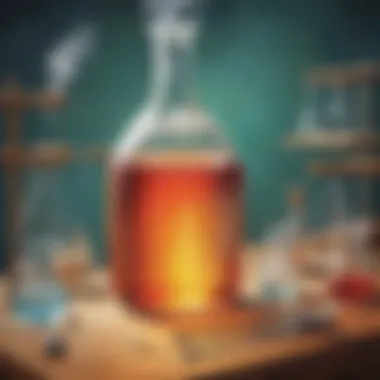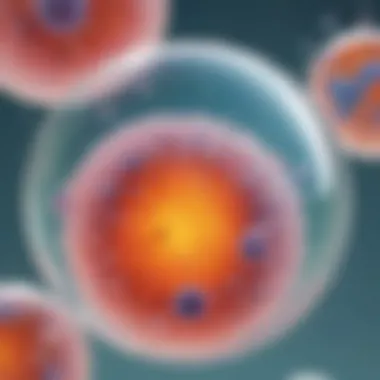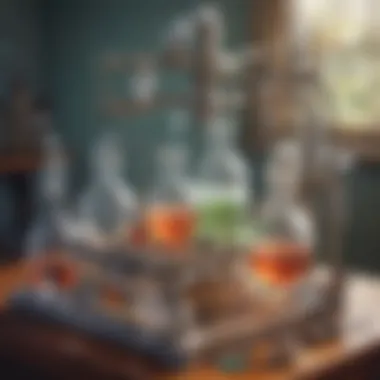Unveiling the Vinegar and Baking Soda Experiment: A Fascinating Exploration of Science


Science Fun Facts
Vinegar and baking soda, two common household items, have fascinating chemical properties that make them react vigorously when combined. This reaction releases carbon dioxide gas, causing bubbling and fizzing. Did you know that this simple experiment can teach us about acid-base reactions and chemical reactions in a fun and interactive way?
Discover the Wonders of Science
Unleash your curiosity by diving into the world of chemistry with the vinegar and baking soda experiment. Watch educational videos and animations that visually explain the science behind the reaction. Explore the real-life applications of this chemical reaction, from homemade volcanoes to eco-friendly cleaning solutions.
Science Quiz Time
Are you ready to test your knowledge of chemistry? Take interactive quizzes to deepen your understanding of the vinegar and baking soda experiment. Challenge yourself with brain teasers and puzzles that make learning fun and engaging. Explore how gamification can enhance your learning experience and make science even more exciting!
Science Experiment Showcase
Get ready for a hands-on experience with fun and engaging experiments using vinegar and baking soda. Follow step-by-step instructions to conduct the experiment safely at home. Check the materials list to ensure you have everything you need to start. Remember to read the safety tips and precautions to make your scientific adventure a safe and successful one.
Prelude to the Vinegar and Baking Soda Experiment
Delving into the intriguing universe of the vinegar and baking soda experiment opens up a world of scientific exploration for young minds. This article sets the stage for an interactive journey through the intricate dance of chemistry between two common kitchen ingredients. By unraveling the mysteries behind this classic experiment, children aged 6 to 12 can grasp the fundamental principles of chemical reactions in a hands-on and engaging manner. The fusion of vinegar and baking soda serves as a gateway to understanding the wonders of science through practical experimentation.
Understanding the Basics
The Role of Vinegar
In the realm of the vinegar and baking soda experiment, vinegar plays a pivotal role as the acidic component in the reaction. Its acidic nature, mainly due to the presence of acetic acid, initiates a cascade of transformations when combined with baking soda. Vinegar's acidity serves as a catalyst for the reaction, stimulating the release of carbon dioxide gas and generating newfound excitement in the scientific process. The versatility and accessibility of vinegar make it a popular choice for this experiment, offering a safe yet impactful medium for chemical exploration.
The Role of Baking Soda
Contrasting vinegar's acidity, baking soda emerges as the alkaline counterpart in the experiment. Baking soda, scientifically known as sodium bicarbonate, acts as the reactive agent that interacts with vinegar to create a spectacle of fizzing and foaming. Its alkaline properties complement vinegar's acidity, leading to the rapid generation of carbon dioxide gas. The affordability and feasibility of using baking soda make it an ideal partner for young scientists embarking on their chemical journey.
Chemical Reaction Overview
The chemical reaction between vinegar and baking soda epitomizes the fusion of an acid and a base, culminating in a captivating display of bubbling and effervescence. This reaction showcases the principles of acid-base chemistry, where the initial mixture transforms into carbonic acid. The subsequent breakdown of carbonic acid releases carbon dioxide gas, showcasing the dynamic nature of chemical transformations. Understanding this overview sets the stage for a deeper dive into the intricacies of chemical reactions, laying a solid foundation for scientific inquiry.


Importance of Safety Measures
Wearing Protective Gear
Prioritizing safety in scientific exploration, the use of protective gear forms a crucial element of the vinegar and baking soda experiment. From goggles to aprons, ensuring that young experimenters are equipped with the necessary protective attire shields them from any potential hazards. The adoption of protective gear not only safeguards against accidental spills or splashes but also instills a sense of responsibility and mindfulness during experimentation.
Supervised Experimentation
Supervised experimentation stands as a guiding principle in navigating the realms of scientific exploration. By having an adult oversee the experiment, children benefit from expert guidance and wisdom, reducing the risk of mishaps and enhancing the learning experience. The presence of a supervisor fosters a collaborative environment where questions are encouraged, and discoveries are celebrated, fostering a culture of safety and shared knowledge.
Setting Up the Experiment
Gathering Materials
Central to the success of the vinegar and baking soda experiment is the meticulous gathering of materials. From vinegar and baking soda to measuring spoons and containers, each item plays a vital role in orchestrating a seamless chemical reaction. The act of gathering materials fosters a sense of preparedness and organization, laying the groundwork for a methodical and structured experiment.
Creating a Safe Workspace
A safe workspace serves as the command center for scientific exploration, providing a designated area free from clutter and distractions. Establishing a dedicated space for the experiment ensures focused attention and minimizes the likelihood of accidents. By creating a safe workspace, children are encouraged to approach the experiment with a sense of purpose and dedication, fostering a conducive environment for discovery and learning.
The Chemical Reaction Process
In this exciting exploration of the Vinegar and Baking Soda Experiment, we delve into the heart of the scientific process. The Chemical Reaction Process is a cornerstone of this article. Understanding the intricate dance between vinegar and baking soda opens up a world of discovery for young minds. The importance lies in the hands-on experience it provides, igniting a curiosity for science that resonates with children aged 6-12. Through dynamic visual cues and interactive elements, this section brings the magic of chemistry to life, fostering a deep appreciation for the scientific method.
Mixing Vinegar and Baking Soda
Visual changes
Visual changes play a pivotal role in showcasing the transformative power of chemical reactions. As the vinegar and baking soda mix, observe the captivating alterations in color and texture. The magic unfolds before your eyes, engaging young scientists with its visual splendor. This hands-on approach not only entertains but also educates, making abstract concepts tangible.
Gas release
The release of gas during the reaction introduces children to the concept of gas production in a tangible manner. Witness the bubbles form and escape, demonstrating the dynamic nature of chemical interactions. This moment of effervescence sparks curiosity and prompts questions, setting the stage for further scientific inquiry.


Heat production
Heat production adds an element of excitement to the experiment as the mixture warms up. Feel the warmth emanating from the reaction vessel, a tangible result of the chemical energy released. This effect underscores the concept of energy transfer, linking theory to real-world observations and deepening understanding.
Understanding the Reaction
Acid-base reaction
The acid-base reaction at the core of this experiment showcases the fundamental principles of chemistry. Witness the vinegar (acetic acid) and baking soda (sodium bicarbonate) interact to form water and carbon dioxide gas. This reaction underscores the importance of pH balance and introduces children to the concept of chemical equilibrium in a simple yet profound manner.
Formation of carbonic acid
The formation of carbonic acid bridges the gap between theory and practice, demystifying the chemical process. Experience firsthand how carbonic acid forms and later decomposes, offering a glimpse into the dynamic nature of chemical reactions. This step highlights the interconnectedness of chemical components, laying the groundwork for future scientific exploration.
Decomposition of carbonic acid
The decomposition of carbonic acid marks a crucial phase in the experiment, showcasing the reversible nature of chemical reactions. Watch as carbonic acid breaks down into water and carbon dioxide, illustrating the delicate balance within chemical systems. This decomposition process reinforces the concept of conservation of mass and energy, inviting young learners to ponder the intricate web of chemical interactions.
Exploring Endothermic and Exothermic Reactions
Heat absorption vs. release
The contrast between heat absorption and release elucidates the concept of endothermic and exothermic reactions. Observe how energy is either absorbed or released during chemical transformations, shaping the temperature changes in the surroundings. This exploration sparks curiosity about energy dynamics and prompts further investigations into the world of thermodynamics.
Impact on the surroundings
The impact on the surroundings serves as a tangible reminder of the interconnectedness of chemical reactions with the environment. Witness how the temperature changes in response to the energy shifts within the system, highlighting the intricate balance of heat transfer. This awareness fosters a sense of environmental responsibility and underscores the role of chemistry in shaping our world.
Real-Life Applications and Extensions
Real-Life Applications and Extensions section in this exhaustive article serves as a bridge between theoretical knowledge and practical experiences for the young scientists delving into the vinegar and baking soda experiment. By elucidating the tangible applications and extensions of this chemical reaction, learners can grasp the relevance of scientific concepts in everyday scenarios. This segment aims to highlight the versatility of the experiment beyond the confines of a laboratory, showcasing its relevance in real-world contexts.
Fizzing Fun: Volcano Eruption Simulation


Materials needed
The incorporation of specific materials in the Volcano Eruption Simulation elevates the interactive nature of the experiment. Materials like baking soda, vinegar, dish soap, food coloring, and a container can facilitate a visually stimulating volcanic eruption display. Each element plays a crucial role in replicating a volcanic reaction, engaging young minds in a creative and informative manner. The combination of these materials not only enhances the educational value of the activity but also fosters an immersive learning experience for children.
Step-by-step guide
The step-by-step guide for the Volcano Eruption Simulation provides a structured approach to executing the experiment successfully. From preparing the volcanic structure to mixing the ingredients in the right proportions, each step contributes to the overall spectacle of the simulation. The guide emphasizes safety measures and proper handling of materials, ensuring a controlled and educational experience for participants. By following the detailed instructions meticulously, children can witness the fascinating chemical reaction unfold before their eyes, fostering curiosity and understanding.
Creating a DIY Carbon Dioxide Fire Extinguisher
Materials list
The creation of a DIY Carbon Dioxide Fire Extinguisher necessitates specific materials to ensure functionality and safety. Items such as vinegar, baking soda, a plastic bottle, and a balloon comprise the essential ingredients for this innovative project. The simplicity of the materials list allows for easy procurement and assembly, making it an accessible and engaging experiment for young learners. The effectiveness and educational value of these materials lie in their ability to demonstrate the principle of carbon dioxide as a fire suppressant in a practical and engaging manner.
Procedure outline
The procedure outline for creating a DIY Carbon Dioxide Fire Extinguisher outlines the sequential steps required to construct and activate the extinguisher. From combining vinegar and baking soda to observing the inflation of the balloon, each stage leads to a comprehensive understanding of gas production and chemical reactions. The clear and concise instructions enable participants to construct a functional fire extinguisher independently, promoting hands-on learning and scientific exploration. By following the outlined procedure, children can witness the practical application of chemical concepts in fire safety scenarios, enhancing their knowledge and skills.
Exploring pH Levels with Household Substances
Testing acidity
Testing acidity with household substances offers a practical insight into the concept of pH levels and acid-base reactions. By using materials such as vinegar, lemon juice, and baking soda, children can conduct simple tests to determine the acidic or alkaline nature of common substances. The hands-on nature of this activity allows young scientists to engage with scientific principles in a familiar environment, fostering a connection between theory and practice. Testing acidity serves as a foundational experiment in understanding the properties of acids and bases, setting the stage for further exploration in chemistry.
Observing reactions
Observing reactions in the context of pH levels exploration allows children to witness chemical changes firsthand. By combining different household substances and noting the resulting reactions, participants can observe color changes, bubbles, or precipitate formation. This observation-based approach enhances scientific inquiry skills and encourages critical thinking in young learners. By closely monitoring the reactions and recording their observations, children can develop a deeper appreciation for the intricacies of chemical phenomena, laying a solid foundation for future scientific endeavors.
Finale: Unleashing the Science Magic
As we reach the conclusion of this enthralling exploration into the vinegar and baking soda experiment, it becomes abundantly clear that the magic of science extends far beyond mere chemical reactions. By engaging in hands-on activities like this experiment, children aged 6-12 can witness the wonders of scientific principles firsthand, igniting a spark of curiosity that could propel them towards a lifelong love for exploration and discovery. Encouraging young minds to question, observe, and explore is not just about understanding the hows and whys of the world around them but also fostering invaluable skills like critical thinking and problem-solving. By embracing scientific exploration, we empower our young scientists to think creatively, analytically, and independently - essential qualities that will serve them well beyond the confines of the laboratory. Through promoting hands-on learning, children are not just passive recipients of knowledge but active participants in constructing their understanding of the world. This interactive approach not only makes learning more engaging and memorable but also cultivates a sense of agency and empowerment in young learners, instilling in them the confidence to explore, experiment, and make sense of the universe.
Encouraging Curiosity and Experimentation
Embracing scientific exploration:
Scientific exploration is a cornerstone of the learning process, encouraging children to ask questions, seek answers, and make connections between theory and practice. By immersing themselves in hands-on experiments like the vinegar and baking soda reaction, youngsters get to experience science in action, transforming abstract concepts into tangible realities. This embodiment of scientific concepts not only enhances comprehension but also nurtures a sense of excitement and wonder, motivating children to delve deeper into the mysteries of the natural world. The unique feature of embracing scientific exploration lies in its ability to instill a sense of wonder and curiosity in young minds, laying the foundation for a lifelong journey of discovery and learning. While this approach requires supervision and guidance to ensure safety and accuracy, the benefits of kindling a passion for science early on far outweigh any challenges or setbacks that may arise.
Promoting hands-on learning:
Hands-on learning is a powerful educational tool that allows children to engage with topics in a dynamic and interactive manner. By actively participating in experiments and activities, students can internalize truncated>







